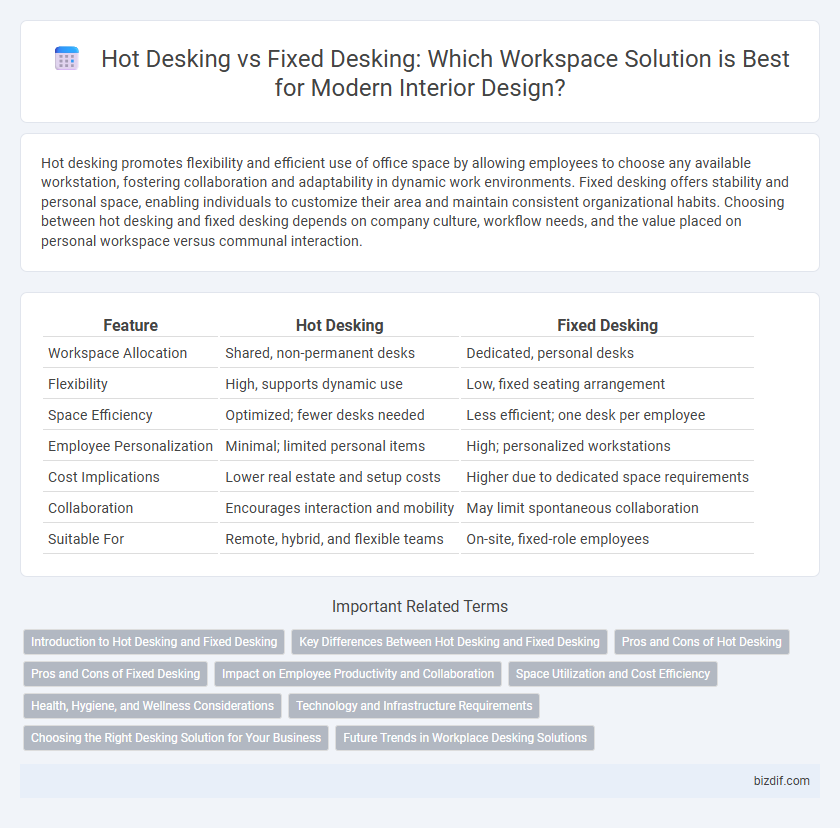Hot desking promotes flexibility and efficient use of office space by allowing employees to choose any available workstation, fostering collaboration and adaptability in dynamic work environments. Fixed desking offers stability and personal space, enabling individuals to customize their area and maintain consistent organizational habits. Choosing between hot desking and fixed desking depends on company culture, workflow needs, and the value placed on personal workspace versus communal interaction.
Table of Comparison
| Feature | Hot Desking | Fixed Desking |
|---|---|---|
| Workspace Allocation | Shared, non-permanent desks | Dedicated, personal desks |
| Flexibility | High, supports dynamic use | Low, fixed seating arrangement |
| Space Efficiency | Optimized; fewer desks needed | Less efficient; one desk per employee |
| Employee Personalization | Minimal; limited personal items | High; personalized workstations |
| Cost Implications | Lower real estate and setup costs | Higher due to dedicated space requirements |
| Collaboration | Encourages interaction and mobility | May limit spontaneous collaboration |
| Suitable For | Remote, hybrid, and flexible teams | On-site, fixed-role employees |
Introduction to Hot Desking and Fixed Desking
Hot desking offers a flexible workspace model where employees use available desks on a first-come, first-served basis, optimizing office space and fostering collaboration. Fixed desking assigns a specific workstation to each employee, providing stability, personalization, and a consistent environment for focused tasks. Both approaches significantly impact office dynamics, employee productivity, and space utilization strategies in modern interior design.
Key Differences Between Hot Desking and Fixed Desking
Hot desking offers flexible workspace utilization by allowing employees to use any available desk, promoting collaboration and reducing real estate costs. Fixed desking assigns permanent desks to individuals, enhancing personalization, privacy, and organization. The key difference lies in flexibility versus stability, impacting team dynamics, space management, and employee preferences in office design.
Pros and Cons of Hot Desking
Hot desking maximizes office space efficiency by allowing multiple employees to share workstations, reducing real estate costs and fostering collaboration among teams. However, it can lead to decreased personal workspace personalization and potential distractions, impacting productivity and employee satisfaction. Organizations must weigh the benefits of flexibility and cost savings against challenges in maintaining team cohesion and individual comfort.
Pros and Cons of Fixed Desking
Fixed desking offers employees a consistent personal workspace, enhancing organization and fostering a sense of ownership, which can improve focus and productivity. However, this setup requires more office space and may reduce flexibility, leading to underutilized desks during remote or hybrid work periods. Fixed desking is ideal for roles needing specialized equipment or privacy but can hinder collaboration in dynamic team environments.
Impact on Employee Productivity and Collaboration
Hot desking encourages dynamic interaction among employees by promoting flexible seating arrangements that foster spontaneous collaboration and idea exchange, enhancing overall productivity. Fixed desking provides employees with a personalized workspace, which can improve focus and task efficiency but may limit cross-team communication and reduce collaborative opportunities. Balancing hot desking and fixed desking strategies can optimize both individual productivity and team collaboration in modern office environments.
Space Utilization and Cost Efficiency
Hot desking maximizes space utilization by allowing multiple employees to share the same workspace, reducing the need for individual desks and lowering real estate costs. Fixed desking provides personal, dedicated workstations but often results in underutilized spaces and higher overhead expenses due to the requirement of more office square footage. Companies seeking cost efficiency and flexible office layouts typically prefer hot desking to optimize office space and minimize operational expenses.
Health, Hygiene, and Wellness Considerations
Hot desking promotes shared use of workspaces, which can increase exposure to germs and allergens, necessitating rigorous cleaning protocols to maintain hygiene. Fixed desking offers a personalized and controlled environment that supports individual hygiene habits and reduces the risk of cross-contamination. Both approaches impact employee wellness by influencing factors such as ergonomic support, personal space, and stress levels related to workspace cleanliness.
Technology and Infrastructure Requirements
Hot desking requires advanced wireless connectivity, cloud-based collaboration tools, and IoT-enabled devices to support dynamic seating arrangements and seamless employee transitions. Fixed desking demands stable, high-speed wired internet connections, personalized hardware setups, and dedicated power outlets to accommodate consistent user needs and specialized equipment. Both setups benefit from robust network security protocols and integrated smart office systems to optimize productivity and resource management.
Choosing the Right Desking Solution for Your Business
Selecting the right desking solution depends on your business's workflow and employee collaboration needs. Hot desking offers flexibility and maximizes space utilization, ideal for dynamic teams and remote work models. Fixed desking provides stability and personalization, better suited for roles requiring consistent equipment and individual focus.
Future Trends in Workplace Desking Solutions
Future workplace desking solutions emphasize flexibility and adaptability, with hot desking gaining momentum due to its support for hybrid work models and space optimization. Advanced technologies like IoT sensors and AI-driven booking systems enhance hot desking efficiency by providing real-time desk availability and personalized workspace environments. Fixed desking remains relevant in roles requiring dedicated equipment or privacy, but trends indicate a growing preference for dynamic, collaborative workspaces designed to foster creativity and employee well-being.
Hot Desking vs Fixed Desking Infographic

 bizdif.com
bizdif.com